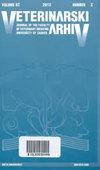Statins modify the response of chicks to challenges with xylazine-ketamine and carbaryl
IF 0.3
4区 农林科学
Q4 VETERINARY SCIENCES
引用次数: 0
Abstract
Statins are known to affect brain function in a manner not related to their dyslipidemic effects. The purpose of the present study was to assess the behavioral response of a chick model (7-14 days old) after single treatments with the statins atorvastatin, fluvastatin or simvastatin at 100 mg/kg, orally, to a pharmacological challenge with an anesthetic regimen of xylazine (5 mg/kg)-ketamine (20 mg/kg), intramuscularly, and a toxicological challenge with the reversible cholinesterase inhibiting insecticide carbaryl (250 mg/kg, orally). Only simvastatin significantly reduced the duration of xylazine-ketamine anesthesia by 47%. Carbaryl at 250 mg/kg, orally induced signs of cholinergic poisoning (57.1 - 100%) in chicks within 3.14 min, and 57.1% death occurred within 85 min. Toxicological challenge of statin-treated chicks with carbaryl also induced signs of cholinergic poisoning, but with varying percentages of reductions compared to the control (carbaryl) group. The reductions in 4 h carbaryl-induced lethality in chicks pre-treated with atorvastatin, fluvastatin and simvastatin were 43, 57 and 29%, respectively, below that of the control value. Correspondingly, their toxicity scores decreased by 18, 18 and 11%, respectively. These data suggest that statins might modulate the functional status of the brain in a manner that affects the impact of centrally acting drugs or toxicants, and hence the behavioral outcomes in chicks. Further studies are warranted on the behavioral effects of statins after prolonged therapy.他汀类药物改变了雏鸡对氯胺酮和西威因的反应
他汀类药物影响脑功能的方式与血脂异常作用无关。本研究的目的是评估单次口服他汀类药物阿托伐他汀、氟伐他汀或辛伐他汀(100mg /kg)后雏鸡模型(7-14日龄)对肌肉注射噻嗪(5mg /kg)-氯胺酮(20mg /kg)麻醉方案的药理学挑战,以及可逆性胆碱酯酶抑制杀虫剂西威因(250mg /kg,口服)的毒理学挑战的行为反应。只有辛伐他汀显著减少了47%的氯胺酮-噻嗪麻醉持续时间。给药剂量为250 mg/kg的西巴威,在3.14分钟内口服诱导雏鸡出现胆碱能中毒的迹象(57.1 - 100%),在85分钟内发生57.1%的死亡。他汀类药物处理的雏鸡也出现了胆碱能中毒的迹象,但与对照(西巴威)组相比,减少的百分比不同。阿托伐他汀、氟伐他汀和辛伐他汀预处理后的雏鸡4 h西巴威致死亡率分别比对照组降低43.7%和29%。相应的,它们的毒性评分分别下降了18%、18%和11%。这些数据表明,他汀类药物可能以某种方式调节大脑的功能状态,从而影响中枢作用药物或毒物的影响,从而影响小鸡的行为结果。他汀类药物在长期治疗后对行为的影响有待进一步研究。
本文章由计算机程序翻译,如有差异,请以英文原文为准。
求助全文
约1分钟内获得全文
求助全文
来源期刊

Veterinarski Arhiv
VETERINARY SCIENCES-
CiteScore
0.80
自引率
20.00%
发文量
22
审稿时长
6-12 weeks
期刊介绍:
The journal Veterinarski arhiv (Vet. arhiv) publishes original scientific papers, case reports, short communications, review papers and book reviews. Occasionally, in supplemental issues, it publishes papers of relevant conferences. The scope of the journal includes all fields of veterinary and animal sciences. Veterinarski arhiv is published by the Faculty of Veterinary Medicine University of Zagreb, six times a year, as an open access, peer-reviewed, international scientific journal. Only unpublished manuscripts may be accepted for the review process. All papers must be written in English and submitted via the Journal''s online submission system (COMET). The content of the Journal is available free of charge and there are no publication charges.
 求助内容:
求助内容: 应助结果提醒方式:
应助结果提醒方式:


